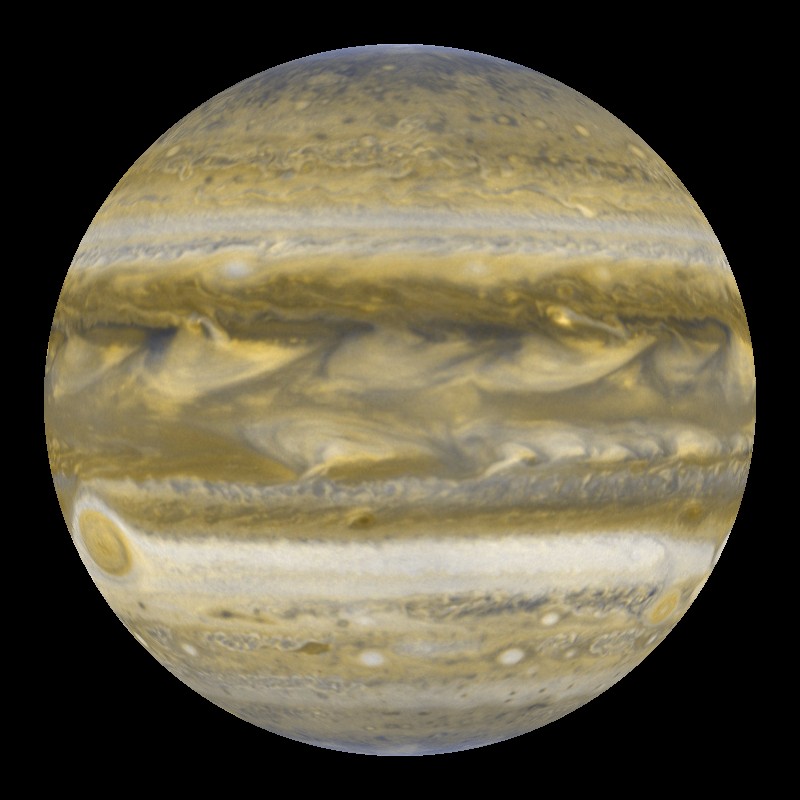Jupiter — Biggest Planet in the Solar System
Description:
The fifth planet in the solar system, Jupiter is the first of the gas planets. It is the largest planet in the solar system with an impressive radius of 44,423 miles, more than 11 times that of Earth, and about one-tenth that of the sun. Because Jupiter is a gas planet, it does not have a solid surface, the gases simply become denser closer to the center, eventually turning into a liquid. Because this planet is not a solid, it easily distorts. In fact, Jupiter, which has the fastest rotation rate in the solar system, bulges at the equator and flattens at the poles due to its rapid rotation. Jupiter’s composition is estimated to be 90% hydrogen and 10% helium with a couple of other trace gases as well. What can be seen from space are the ammonia clouds that surround the planet. The visible bands of color are the result of very high velocity winds that flow in opposite directions in adjacent bands. Within these bands are storms that have raged on for years. The most notable is the Great Red Spot, a storm that has been observed for 300 years. Three Earth’s could easily fit into the Great Red Spot.
Jupiter has been described as its own little solar system because of the vast number of moons orbiting the planet. There are 63 moons around Jupiter, the most of any planet in the solar system. Four in particular, Io, Europa, Ganymede, and Callisto, are planet sized. In 2003 alone, 23 new moons were discovered. Reasons for this incredible number of moons include the strong gravitational force of the planet at 20.87 m/s2, more than double the gravitational force on Earth, and also the large magnetic field of the planet, which extends into Saturn’s orbit. Like Saturn, Jupiter also has rings, though they are only visible when backlit by the sun and believed to be comprised of dust kicked up from meteor collisions with the four biggest moons.
Several new Jupiter datasets have come from both the Hubble Space Telescope and the New Horizons spacecraft. The New Horizons spacecraft was launched in January of 2006 with the goal of studying Pluto in 2015. On its way to Pluto, New Horizons has provided pictures of other planets as well. The black and white animation of Jupiter that is available for SOS is made of images from New Horizons spacecraft that have been overlaid on a Hubble Space Telescope image from 2007. The Hubble Space Telescope datasets include surface pictures from February and March of 2007 that show the Great Red Spot and the Red Spot Junior, a sequence of images that show the different layers of Jupiter's atmosphere by varying the spectrum, and a view of Jupiter after it was hit by a comet.
Notable Features:
- Great Red Spot — storm on surface observed for 300 years
-
- It moves East/West but never North/South
- Bands of color created by the high winds in opposite directions
Notable Features: Hubble Space Telescope and New Horizons Datasets
- The Red Spot Junior is visible
Data Category
Major: Astronomy
Minor: Jupiter
Keywords:
Solar System, planet, biggest
| Data Set Name |
Jupiter (still) |
| Data Set Directory Name |
jupiter/still |
| Data Set Source |
Cassini Image details |
| Data Set Developer |
Cassini Imaging Team |
| Visualization Developer |
Steve Albers, NOAA/GSD |
| Audio |
No |
| Download |
FTP |
| Data Set Name |
Jupiter Shoemaker-Levy Comet Collision |
| Data Set Directory Name |
jupiter/comet_collision |
| Data Set Source |
Hubble Space Telescope 1994 |
| Data Set Developer |
NASA Goddard Space Flight Center |
| Visualization Developer |
NASA Goddard Space Flight Center |
| Audio |
No |
| Contact |
NASA Goddard Space Flight Center |
| Download |
FTP |
| Data Set Name |
Jupiter HST sequence 2007 |
| Data Set Directory Name |
jupiter/HST_sequence_2007 |
| Data Set Source |
Hubble Space Telescope 2007 |
| Data Set Developer |
NASA Goddard Space Flight Center |
| Visualization Developer |
NASA Goddard Space Flight Center |
| Audio |
No |
| Contact |
NASA Goddard Space Flight Center |
| Download |
FTP |
| Data Set Name |
Jupiter New Horizon Flyby LORRI sequence 2007 |
| Data Set Directory Name |
jupiter/new_horizons_black |
| Data Set Source |
New Horizons |
| Data Set Developer |
NASA Goddard Space Flight Center |
| Visualization Developer |
NASA Goddard Space Flight Center |
| Audio |
No |
| Contact |
NASA Goddard Space Flight Center |
| Download |
FTP |
| Data Set Name |
Jupiter with 2 Red Storms by HST Feb2007 |
| Data Set Directory Name |
jupiter/two_storms_feb2007 |
| Data Set Source |
Hubble Space Telescope 2007 |
| Data Set Developer |
NASA Goddard Space Flight Center |
| Visualization Developer |
NASA Goddard Space Flight Center |
| Audio |
No |
| Contact |
NASA Goddard Space Flight Center |
| Download |
FTP |
| Data Set Name |
Jupiter with 2 Red Storms by HST Mar 25, 2007 |
| Data Set Directory Name |
jupiter/two_storms_mar2007 |
| Data Set Source |
Hubble Space Telescope 2007 |
| Data Set Developer |
NASA Goddard Space Flight Center |
| Visualization Developer |
NASA Goddard Space Flight Center |
| Audio |
No |
| Contact |
NASA Goddard Space Flight Center |
| Download |
FTP |


 Jupiter - still (5 mb)
Jupiter - still (5 mb) Jupiter with 2 Red Storms by HST Feb2007 (3 mb)
Jupiter with 2 Red Storms by HST Feb2007 (3 mb)